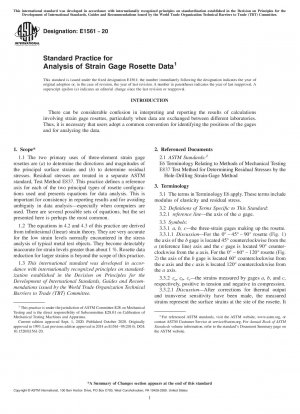ASTM E1561-20
Standard Practice for Analysis of Strain Gage Rosette Data
- Standard No.
- ASTM E1561-20
- Release Date
- 2020
- Published By
- American Society for Testing and Materials (ASTM)
- Latest
- ASTM E1561-20
- Scope
- 1.1 The two primary uses of three-element strain gage rosettes are (a) to determine the directions and magnitudes of the principal surface strains and (b) to determine residual stresses. Residual stresses are treated in a separate ASTM standard, Test Method E837. This practice defines a reference axis for each of the two principal types of rosette configurations used and presents equations for data analysis. This is important for consistency in reporting results and for avoiding ambiguity in data analysis—especially when computers are used. There are several possible sets of equations, but the set presented here is perhaps the most common. 1.2 The equations in 4.2 and 4.3 of this practice are derived from infinitesimal (linear) strain theory. They are very accurate for the low strain levels normally encountered in the stress analysis of typical metal test objects. They become detectably inaccurate for strain levels greater than about 1 %. Rosette data reduction for larger strains is beyond the scope of this practice. 1.3 This international standard was developed in accordance with internationally recognized principles on standardization established in the Decision on Principles for the Development of International Standards, Guides and Recommendations issued by the World Trade Organization Technical Barriers to Trade (TBT) Committee.
ASTM E1561-20 Referenced Document
- ASTM E6 Standard Terminology Relating to Methods of Mechanical Testing
- ASTM E837 Standard Test Method for Determining Residual Stresses by the Hole-Drilling Strain-Gage Method
ASTM E1561-20 history
- 2020 ASTM E1561-20 Standard Practice for Analysis of Strain Gage Rosette Data
- 1993 ASTM E1561-93(2014) Standard Practice for Analysis of Strain Gage Rosette Data
- 1993 ASTM E1561-93(2009) Standard Practice for Analysis of Strain Gage Rosette Data
- 1993 ASTM E1561-93(2003) Standard Practice for Analysis of Strain Gage Rosette Data
- 1993 ASTM E1561-93(1998) Standard Practice for Analysis of Strain Gage Rosette Data
